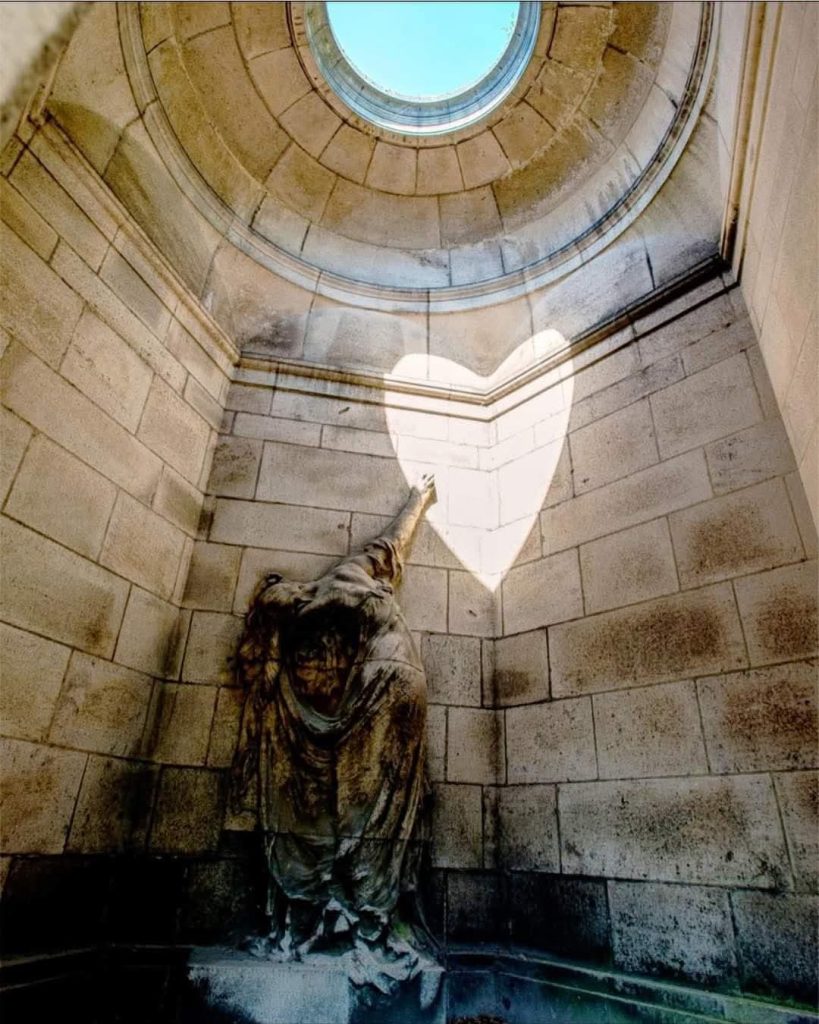In the historic Laeken Cemetery in Brussels, Belgium, an extraordinary event unfolds each year that blends art, astronomy, and emotion into a breathtaking spectacle. Hidden among the rows of solemn gravestones and quiet mausoleums lies the tomb of Léonce Evrard and his wife, Louise Flignot—a structure that might appear ordinary to the untrained eye. Built in 1920, this mausoleum holds a secret so remarkable that it draws visitors and art lovers alike, all waiting to witness a fleeting moment that only occurs once annually. What appears to be a quiet, stone structure transforms into a scene of wonder and light on a single day in June, captivating the hearts of those lucky enough to see it.

The mausoleum itself does not stand out at first glance. It’s modest in design, with a somber sculpture of a grieving figure reaching out toward a blank stone wall. This expression of mourning, carved in cold stone, conveys a deep sense of loss and longing. Yet, the statue is more than a tribute to sorrow. It’s part of a grand design—one that reveals itself in an awe-inspiring moment orchestrated not just by human hands but by the movement of the heavens. The transformation that occurs within this mausoleum is not random, nor is it a product of luck or coincidence. It is a carefully calculated masterpiece of human creativity and astronomical awareness.
Each year on June 21st, the summer solstice—the longest day of the year—the sun aligns perfectly with a small, intentional opening in the roof of the mausoleum. For just fifteen minutes, sunlight streams through this aperture and creates a beam in the shape of a perfect heart. This radiant heart of light hovers gently above the hand of the stone mourner, illuminating the figure in a way that feels both spiritual and surreal. The mourner appears to be reaching not toward emptiness, but toward love—symbolized by this momentary gift of sunlight.
This brief occurrence is anything but accidental. The architects and designers behind the Evrard mausoleum intended this exact phenomenon. Every element, from the angle of the roof opening to the positioning of the statue’s hand, was designed with precision so that, on this specific day of the year, the sun would cast a symbol of love directly into the tomb. The result is a moment that transcends time and place—where architecture, science, and sentiment all meet in perfect harmony. In a cemetery filled with reminders of loss, this heart of light offers a moment of healing, reminding us of the enduring power of love even in the face of death.
For decades, this annual solstice event has quietly attracted visitors from Belgium and beyond. They gather in respectful silence, waiting to witness this sacred alignment. Many are drawn not only by the architectural and astronomical marvel but by the emotional experience it offers. Watching the heart of light appear and slowly fade is like watching love manifest itself in pure form—a phenomenon both ephemeral and eternal. It’s a powerful symbol that speaks across generations and cultures, touching something universal in all of us.
The mausoleum of Léonce Evrard and Louise Flignot is a testament to the brilliance of those who built it. In designing a tomb that only reveals its deepest beauty once a year, they have created a metaphor for life itself: a series of ordinary days punctuated by extraordinary moments. The precision of the solstice alignment required more than artistic talent—it required an understanding of astronomy, mathematics, and engineering. But perhaps more importantly, it required heart. To conceive such a display, one must believe that love can endure through stone, through time, and through the quiet cycles of the earth and sun.
There’s something profoundly human about this fusion of art and science. It reminds us that our ancestors were not only builders and thinkers but dreamers. They looked to the stars not just for navigation or survival but for inspiration. In the case of this mausoleum, that inspiration took form in a heart of light—a shape universally recognized and emotionally charged. It demonstrates that even in grief, there is room for beauty; that remembrance can be more than mourning—it can be celebration, reflection, and even awe.
In a modern world dominated by fleeting digital interactions and disposable experiences, the solstice light in the Laeken Cemetery offers something rare: a moment that cannot be captured or replicated, only experienced. It forces us to slow down, to be present, to stand still and marvel at the delicate balance between nature and human expression. For those who witness it, the experience often leaves a lasting impression—one not easily put into words, but deeply felt.
As each year passes, the sunlight continues its timeless journey across the sky, always returning to this quiet corner of Brussels. It pauses just long enough to light a stone hand reaching toward love, reminding us that even in places dedicated to memory and loss, new meaning can emerge. The mausoleum does more than house the remains of a couple—it keeps alive a story, a vision, and a tradition that unites architecture, emotion, and the cosmos.
This unique convergence of design and destiny, occurring for just fifteen minutes each year, stands as a powerful reminder that the greatest monuments are not those that dominate the skyline, but those that touch the soul. In its quiet brilliance, the Evrard mausoleum whispers a message across time: love endures, light returns, and even in silence, beauty speaks.





